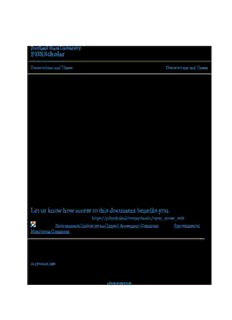
Studies of ecological factors that affect the population and distribution of the western gray squirrel PDF
Preview Studies of ecological factors that affect the population and distribution of the western gray squirrel
PPoorrttllaanndd SSttaattee UUnniivveerrssiittyy PPDDXXSScchhoollaarr Dissertations and Theses Dissertations and Theses 1992 SSttuuddiieess ooff eeccoollooggiiccaall ffaaccttoorrss tthhaatt aaffffeecctt tthhee ppooppuullaattiioonn aanndd ddiissttrriibbuuttiioonn ooff tthhee wweesstteerrnn ggrraayy ssqquuiirrrreell iinn nnoorrtthhcceennttrraall OOrreeggoonn Susan Ann Foster Portland State University Follow this and additional works at: https://pdxscholar.library.pdx.edu/open_access_etds Part of the Environmental Indicators and Impact Assessment Commons, and the Environmental Monitoring Commons Let us know how access to this document benefits you. RReeccoommmmeennddeedd CCiittaattiioonn Foster, Susan Ann, "Studies of ecological factors that affect the population and distribution of the western gray squirrel in northcentral Oregon" (1992). Dissertations and Theses. Paper 2383. https://doi.org/10.15760/etd.2380 This Dissertation is brought to you for free and open access. It has been accepted for inclusion in Dissertations and Theses by an authorized administrator of PDXScholar. Please contact us if we can make this document more accessible: [email protected]. STUDIES OF ECOLOGICAL FACTORS THAT AFFECT THE POPULATION AND DISTRIBUTION OF THE WESTERN GRAY SQUIRREL IN NORTHCENTRAL OREGON by SUSAN ANN FOSTER A dissertation submitted in partial fulfillment of the requirements for the degree of DOCTOR OF PHILOSOPHY in ENVIRONMENTAL SCIENCES AND RESOURCES: BIOLOGY Portland State University ©1992 TO THE OFFICE OF GRADUATE STUDIES: The members of the Committee approve the dissertation of Susan Ann Foster presented January 10, 1992. Richard B. Forbes, Chair Robert O. Tinnin Richard R. Petersen Daniel M. Johnson David W. McClure Thomas Palm / APPROVED: Robert O. Tinnin, Chair, Department of Biology C. William Savery, Interim Vice Provost foi$2rraadduate Studies and Research ACKNOWLEDGEMENTS I thank the many people who have encouraged me in the process of this dissertation, especially Professors Richard Forbes, Robert Tinnin, and Richard Petersen. Professors David McClure, Daniel Johnson and Thomas Palm provided many helpful comments. I am especially grateful to my friends, Ellen Benedict, Ruth McFarland and Sally Martin, who endured subzero and 110°F weather with me measuring, tracking, and sampling parts. I am indebted to the Dental Hygiene Lab at Mt. Hood Community College for use of their x-ray equipment and expertise, the CAD lab personnel for their patience, and the Science Division for frequent manipulation of my schedule to allow me time to do this research. I thank Donald Crimmins, DVM, of the Rockwood Animal Clinic for information and consultation. I am grateful for the typing skills of Darlene Maddox and her assistance in editing this dissertation. Finally, I would like to acknowledge the continued faithful companionship of Patti, the wonder dog. TABLE OF CONTENTS PAGE ACKNOWLEDGEMENTS .................................................................................. iii LIST OF TABLES ................................................................................................ vii LIST OF FIGURES...................................................................................................... ix CHAPTER I INTRODUCTION ............................................................................. 1 n REVIEW OF THE LITERATURE ................................................. 5 Habitat Requirements................................................................. 6 Nests and Nest Trees................................................................. 8 Food Habits ............................................................................... 9 Home Range............................................................................... 11 Age Determination .................................................................... 12 Reproduction............................................................................... 13 III STUDY AREA ................................................................................... 15 IV METHODS AND MATERIALS....................................................... 19 Food Habits ............................................................................... 19 Live Trapping............................................................................ 20 Home Range............................................................................... 21 Age Determination .................................................................... 22 Habitat Requirements................................................................. 24 V RESULTS............................................................................................. 27 Food Habits ............................................................................... 27 Size ............................................................................................. 30 Reproduction and Growth........................................................ 30 Live-Trapping Results .............................................................. 37 Home Range............................................................................... 44 Age Determination .................................................................... 46 Nest Trees .................................................................................. 47 VI DISCUSSION.............................................................................. 71 VII CONCLUSIONS AND RECOMMENDATIONS................... 83 Conclusions.................................................................................. 83 Recommendations....................................................................... 84 REFERENCES CITED AND ADDITIONAL LITERATURE....................... 87 APPENDICES A HUNTER COOPERATION PROGRAM INFORMATION SHEET ................................................................................................ 96 B RAW DATA FROM HUNTER COOPERATION PROGRAM INCLUDING HUNTING SEASON ROADKILLS AND ANIMALS OBTAINED FROM OREGON DEPARTMENT OF FISH AND WILDLIFE AND OREGON STATE POLICE PERSONNEL FOR STOMACH CONTENT ANALYSIS ....................... 98 vi C NEST TREE SITE MAPS.................................................................. 133 D NEST BOX DESIGN.......................................................................... 153 LIST OF TABLES TABLE PAGE I Stomach Content Analysis of 14 Western Gray Squirrels, 1981-1984 ............................................................................... 28 II Size of Live-Trapped Squirrels.......................................................... 31 III Data on Reproductive Status of Live-Trapped Female Squirrels.................................................................................. 32 IV Data on Reproductive Status of Live-Trapped Male Squirrels ... 33 V Data on Lactating Female Squirrels Taken in the Hunter Cooperation Program, August-November, 1981-1987 . . 34 VI Results of Live Trapping, 1981-1986 ............................................... 38 VII Recaptured Western Gray Squirrels .................................................. 39 VIII Sex Ratios and Capture Rates for Live-Trapped Western Gray Squirrels......................................................................... 42 IX Main Trap Competitors, 1981-1986 .................................................. 43 X Other Species Trapped, 1981-1986 .................................................. 44 XI Home Ranges of Eight Western Gray Squirrels.............................. 45 XII Squirrels from Hunter Cooperation Program Arranged by Sex and Age............................................................................ 47 XIII Skull Measurements of Known-Age Squirrels................................. 50 viii XIV Site Characteristics ............................................................................. 53 XV Nest Tree and Non-Nest Tree Characteristics ................................ 55 XVI Percentage of Cover in One-Fifth Acre Plot of Nest Tree Sites ............................................................................... 58 XVH Basal Area of Nest Tree Sites............................................................ 60 LIST OF FIGURES FIGURE PAGE 1. Study A rea........................................................................................... 16 2. Site Measurements of Nest Tree Sites............................................... 25 3. Numbers of Squirrels of Each Age Category Taken in the Hunter Cooperation Program, 1981-1987.......................................... 48 4. Mean, Standard Deviation, and Range of Greatest Skull Length of Squirrels Taken in the Hunter Cooperation Program, 1981-1987................................................................................. 51 5. Mean, Standard Deviation, and Range of Least Interorbital Breadth of Squirrels by Age Taken in the Hunter Cooperation Program, 1981-1987 .............................................................. 52 6. Nest Tree Site 072 .............................................................................. 62 7. Nest Tree Site 081 .............................................................................. 63 8. Nest Tree Site 089 .............................................................................. 64 9. Nest Tree Site 091 .............................................................................. 65 10. Nest Tree Site 092 .............................................................................. 66 11. Cutaway Side View of a Western Gray Squirrel Nest Taken From a Prime Nest Site...................................................................... 68
Description: